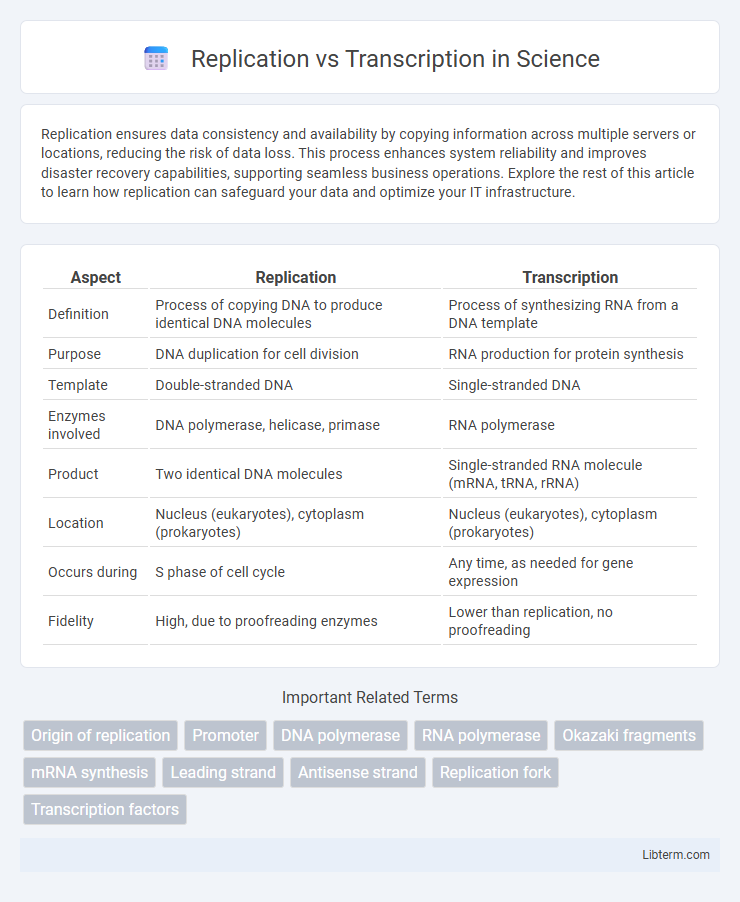Replication ensures data consistency and availability by copying information across multiple servers or locations, reducing the risk of data loss. This process enhances system reliability and improves disaster recovery capabilities, supporting seamless business operations. Explore the rest of this article to learn how replication can safeguard your data and optimize your IT infrastructure.
Table of Comparison
| Aspect | Replication | Transcription |
|---|---|---|
| Definition | Process of copying DNA to produce identical DNA molecules | Process of synthesizing RNA from a DNA template |
| Purpose | DNA duplication for cell division | RNA production for protein synthesis |
| Template | Double-stranded DNA | Single-stranded DNA |
| Enzymes involved | DNA polymerase, helicase, primase | RNA polymerase |
| Product | Two identical DNA molecules | Single-stranded RNA molecule (mRNA, tRNA, rRNA) |
| Location | Nucleus (eukaryotes), cytoplasm (prokaryotes) | Nucleus (eukaryotes), cytoplasm (prokaryotes) |
| Occurs during | S phase of cell cycle | Any time, as needed for gene expression |
| Fidelity | High, due to proofreading enzymes | Lower than replication, no proofreading |
Introduction to Replication and Transcription
Replication duplicates the entire DNA molecule, ensuring genetic material is accurately passed to daughter cells during cell division. Transcription converts a specific DNA sequence into messenger RNA, which serves as a template for protein synthesis. Both processes involve enzymes like DNA polymerase in replication and RNA polymerase in transcription, functioning within the nucleus of eukaryotic cells.
Definitions: Replication vs Transcription
Replication is the biological process where DNA makes an exact copy of itself, ensuring genetic information is passed accurately during cell division. Transcription, on the other hand, is the process of synthesizing messenger RNA (mRNA) from a DNA template, enabling the transmission of genetic instructions for protein synthesis. Both processes involve nucleic acid sequences but serve distinct functions: replication duplicates the genome, while transcription converts genetic code into a working RNA molecule.
Key Enzymes Involved in Each Process
DNA replication primarily involves the enzyme DNA polymerase, which synthesizes a new strand complementary to the original DNA template, along with helicase unwinding the double helix and primase laying down RNA primers. Transcription relies on RNA polymerase to create an RNA copy from the DNA template strand, with transcription factors facilitating the enzyme's binding and initiation processes. Both processes utilize specific enzymes that ensure the accurate transfer of genetic information, with DNA polymerase focusing on DNA duplication and RNA polymerase dedicated to RNA synthesis.
Main Functions and Biological Significance
Replication ensures the accurate duplication of the entire DNA molecule, preserving genetic information for cell division and inheritance. Transcription selectively converts specific DNA segments into RNA, enabling protein synthesis and gene expression regulation. Both processes are fundamental for cellular function, with replication maintaining genetic stability and transcription allowing dynamic responses to environmental changes.
Step-by-Step Overview of Replication
Replication begins with the unwinding of the double helix by helicase, creating a replication fork. DNA polymerase attaches to each strand and adds complementary nucleotides in a 5' to 3' direction, synthesizing the leading and lagging strands simultaneously. Ligase seals gaps between Okazaki fragments on the lagging strand, ensuring continuity of the newly synthesized DNA molecules.
Step-by-Step Overview of Transcription
Transcription begins with the binding of RNA polymerase to the DNA promoter region, initiating the unwinding of the DNA helix. RNA polymerase then reads the template DNA strand from 3' to 5', synthesizing a complementary RNA strand in the 5' to 3' direction by adding ribonucleotides. The process concludes when RNA polymerase encounters a terminator sequence, causing the release of the newly formed RNA transcript and the detachment of the enzyme from the DNA.
Differences in Template Usage and Product
Replication uses the entire double-stranded DNA as a template to produce a complete copy of the genome, resulting in two identical double-stranded DNA molecules. Transcription uses only a specific segment of one DNA strand, the template strand, to synthesize a complementary single-stranded RNA molecule. While replication produces DNA for cell division, transcription generates RNA molecules for protein synthesis and gene regulation.
Regulation Mechanisms of Replication and Transcription
Regulation of replication involves origin recognition complexes and licensing factors that ensure DNA is duplicated once per cell cycle, while transcription regulation depends on promoter regions, enhancers, and transcription factors controlling RNA polymerase activity. Epigenetic modifications, such as DNA methylation and histone acetylation, play key roles in both processes by altering chromatin accessibility. Checkpoint proteins monitor replication fidelity to prevent genomic instability, whereas transcriptional regulation dynamically responds to cellular signals to adjust gene expression levels.
Errors, Proofreading, and Mutation Rates
Replication involves the copying of DNA strands with high fidelity due to extensive proofreading by DNA polymerase's 3' to 5' exonuclease activity, resulting in a mutation rate as low as 10^-9 per base pair per replication. Transcription is error-prone compared to replication because RNA polymerase lacks robust proofreading mechanisms, leading to higher mutation rates around 10^-5 to 10^-6 per transcribed base. Errors in replication can cause permanent mutations if not corrected by mismatch repair systems, while transcriptional errors are transient and generally do not result in heritable mutations.
Summary Table: Replication vs Transcription
Replication duplicates the entire DNA molecule, creating two identical DNA strands, whereas transcription converts a specific DNA segment into RNA. Replication involves enzymes like DNA polymerase and occurs during the S phase of the cell cycle; transcription uses RNA polymerase and takes place in the nucleus. The final products differ: replication produces double-stranded DNA, while transcription results in single-stranded messenger RNA (mRNA).
Replication Infographic

 libterm.com
libterm.com